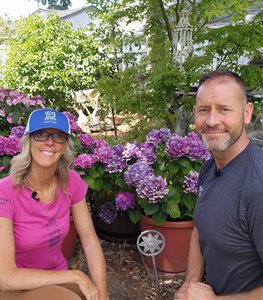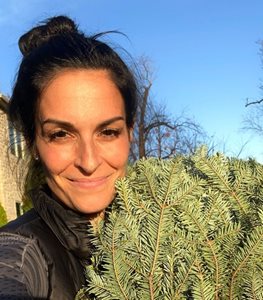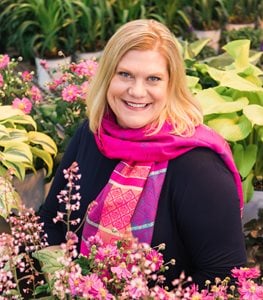24 LESSONS LEARNED IN THE GARDEN
24 gardeners share lessons they learned this past year in their gardensGardening is a never-ending journey of discovery. Just when you think you have a handle on things, Mother Nature reminds you that she's in charge. From the subtle shifts in weather patterns to the unexpected appearances of pests or the sudden burst of growth in a new plant, there's always something to learn. It's a humbling reminder that nature is full of surprises and even the most seasoned gardeners are always learning and adapting.
We asked a few of our friends to share with us a lesson they learned in their garden this past year. Here's what they had to say:
You Can't Control Mother Nature
Janey, Dig, Plant, Water, Repeat, on YouTube and Instagram
Northern CA, Zone 9B
"The lesson I learned in my garden this year is that no matter how hard I try, I can’t control Mother Nature. It could be that 10-day heat wave, or a freak cold spell, an injury that prevents me from tending to my garden, or an attack from unwanted critters. This year more than ever I learned not be discouraged by Mother Nature, rather to appreciate the beauty and the unpredictability she offers. It’s what makes gardening a challenge and so much fun."
Container Game-Changer
Bethany, of Chicago Gardener, on YouTube and Instagram
Chicago, IL, Zone 6A
"I have been container gardening for five years, and it wasn't until this season I decided to put wheeled platforms under my pots. It was a complete game changer. I can now easily move my large and heavy pots around the garden with minimal effort. It also keeps the pots lifted off of my wood deck which helps prevent damage to the deck. It also improved pot drainage. It's such a simple change that has improved gardening so much for me. If I could turn back time, I would also add wheels to the legs of my elevated beds, but those are filled with soil so it's too late for that now."
Timing is Everything
Heather, of Heather Here She Grows, on YouTube and Instagram
Chicago, IL, Zone 5B
"Timing your sweet corn harvest is an art form. It's one of those Goldilocks crops that needs to be harvested at just the right time for maximum sweetness. Harvest too early and the kernels are too small and lack sweetness. Harvest too late (guilty) and the juice turns to a gummy starch. Sweet corn ripens right around the time the silk turns brown and shrivels up. Once that happens, you have a three-day window to harvest before the sugars turn to starch. I missed that window by a few days and it made a HUGE difference. There's always next year!"
Patience is a Virtue
Eric and Christopher, of Grow for Me 5B, on YouTube and Instagram
Upstate NY, Zone 5B
"GrowForMe5b is located in Upstate NY with an average last frost date of about May 8th. One thing we learned this year is to be patient! We experienced an extremely mild spring. The sun was shining, the plants were waking up, and come May 8th the garden was green and happy. We took this opportunity to get a jump on planting our seedlings out into the garden. Lo and behold, May 23rd brought us a hard frost and all but a few of our seedlings were lost, even the ones protected with frost cloths. Moving forward we will not be fooled again! Average last frost date is exactly that, an average. It does not guarantee there will not be a frost after that date. Patience is a virtue."
Pushing the Envelope
Erin, of The Impatient Gardener, also on YouTube and Instagram
Southeast WI, Zone 5
"Keep pushing the envelope: That's what I took away from my 2023 garden. I've found so much joy in trying plants that are a departure from the plants we typically see in our area. I've been bringing in more tropicals and playing with unusual annuals grown from seed. It doesn't always work, but I always learn something—and when it does work, it's a delight to offer a bit of a surprise in the garden."
Letting Go
Morgan, of @coffee.and.chlorophyll, on Instagram
Central WY, Zone 5A
"Following an unusually harsh winter, the extended growing season of 2023 underscored the unpredictable nature of each year. I planted flowers around my vegetable garden to my heart’s content, and once again basked in the knowledge that vegetables (and I) love flowers, and that everything truly thrives when planted in properly amended soil. The most significant lesson learned from this year’s garden, however, came from letting go—uprooting plants that no longer bring me joy. It was a bittersweet act, pulling out a few shrubs and perennials that have been in the ground under my care for the last few years, but the void left behind created fresh opportunities. I learned that it is okay to replace the old and underperforming, with new plants that I hope will flourish!"
Watch the Light
Sean and Allison, of Spoken Garden, on YouTube and Instagram
WA, Zone 9A
"No one wants stretchy, leggy hydrangea stems. With our garden completely planted in containers (and at a separate location), this year was a challenge for us to monitor the changing light levels of our plants, especially our hydrageas. We observed more stretching growth this year than previous years due to the changing angle of the sun throughout the growing season and the lower light levels where the containers were placed, showing us that our hydrangeas were more sensitive to light levels than our other plants. Next year, since our hydrangeas will stay in the same containers, we’ll keep better track of the changing light levels and move our containers accordingly, so their stems won’t stretch and become leggy like they did this past year."
Finding Joy
Tracey, of @Tracey_Hiebert, on Instagram
Southern Ontario, Canada, Canadian Zone 6B / USDA Zone 5-6
"Well, I've finally come to the conclusion that my garden won’t have any hollyhocks—and I love hollyhocks. They are such a cottage garden staple. They remind me of my Grandma's garden, and how she would make small dolls from the flowers for us. I have grown them in my garden for a few years, but every year they are struck with disease, mainly rust, and pests just love them! By the middle of summer, they end up looking scraggly. I was determined to give them another shot, so I purchased some disease-resistant varieties and started them from seed. They were doing great, but then the Japanese beetles decimated them. We spent more time pulling the beetles off of the flowers than enjoying them. We ended up pulling them all out, and they will be replaced with flowers that are native to my area. To me, a garden should be enjoyed, and I have learned that fighting with flowers that just aren’t a good fit is not enjoyable—no matter how much I love them. I will enjoy them in others gardens, and have fun picking out some native varieties that will compliment my cottage garden and spend my time wandering the paths with the kitties."
Nature's Balance
Melissa, of @fancyflowerfarmer, on Instagram
Kansas City, Zone 6B
"After years of battling thrips with every man-made product possible, followed by the last two years of just letting Mother Nature take over, resulted in the first season that I did not see a single thrip on my property. I have learned some tremendous lessons over the years through gardening, but the lesson of allowing nature to just be, has been the biggest lesson yet. I no longer fight against nature. I just allow it to be, to create balance and enjoy."
Let Go of Stress
Robbie, of Visit Our Garden, on YouTube and Instagram
Northern CA, Zone 9A
"The biggest lesson I learned this year was “I am not in control”. I had to learn to let go of things out of my control in the garden this year. Once I had my mind clear of all the little things I stressed over, gardening continued to be fun again. There’s always next year to try again!"
Two Tiers Are Better Than One
Stacy, of Bricks 'n Blooms, also on YouTube and Instagram
Northern NJ, Zone 6A
"While I’ve been gardening for over 25 years, I am amazed with how much I continue to learn! This year, I learned that I need two tiers of trellis netting for my cut flower garden instead of just one. I thought I could slowly raise the one as the flowers grew but they all grew at different rates so that wasn’t very effective. And I wound up adding additional supports throughout the season to keep the taller, heavier flowers upright. It would be much less work using two layers of trellis netting from the outset. It won’t look pretty at first, but that’s a lower maintenance approach than what I did this year."
Adapting to Change
Sam, of Margaret Valley Landscaping, on Instagram
Kelowna, B.C., Canada, Zone 6A
"This year, I have learned about the powerful effects of climate change and how we need to adapt our garden practices to handle it. For example, we have always been able to do a full fall cleanup that includes trimming most perennials flush to the ground, leaf removal, and hard pruning to eliminate some of the spring prep. But now we have had to adjust that, leaving most of the work for the spring so our plants can survive our winters.
Another major learning curve is waiting longer in spring to maintain and prune plants such as roses, butterfly bush, and sensitive perennials like lavender because of the late frosts we have been getting in the last two years.
As challenging and stressful as these changes may be, it is all a part of gardening in our ever-changing environment!"
Natural Materials for the Win
Matthew, of The Southerner's Northern Garden, on YouTube and Instagram
Southwest OH, Zone 6
"For years I've used natural (uncolored) triple shred mulch for my garden. At my new property, I've been experimenting with simple shredded wood chips from a local arborist and have loved both the results and the look—not to mention the cost savings! I'd encourage you to try top dressing your woodland or shade garden beds with natural, less processed materials. It creates an instant natural and relaxed feel for a garden with plants you may have carefully curated. Reach out to a local arborist. They may enjoy a place to dispose of wood chips and you (and your garden) can reap the benefits. In other areas, simple compost can be an alternative to mulch altogether, especially in beds where you want a little extra pop of contrast to make your plants shine. In some areas, your local municipality may even provide free compost as a part of its leaf collection program. In either case, thoughtfully save some money to buy more plants!"
Functional + Ecological = Beautiful
Lisa, Paper Garden Workshop, also on Instagram
Des Moines, IA, Zone 5B
"We bought our lovely, small urban house and garden in the heart of Des Moines in 2020 (Zone 5b). Since then I've struggled a bit to find the right community of plants to thrive under our 100+ year old oak canopy. Between understanding shade density (in different parts of the yard) and impactful dog playing, it's been a bit of a challenge establishing a tough matrix planting (green mulch) to cover the ground. Our house is over 100 years old, so amazingly I've noticed many native plants (several carex species, Soloman's seal, plus others that I'm still trying to identify) popping up here and there. I finally came to the realization to invest in what I have and add to it (with other natives and site-adapted species). The carex, in particular, holds up to the dog traffic well and I love how the wide-leafed ones mix with the fine-leafed ones. I've also enjoyed arranging these native plants in a horticultural way with aesthetics, texture and spatial definition in mind. They are functional, ecologically grounded and beautiful."
Go Big or Go Home
Skye, @hamiltonhousedesigns on Instagram
Southwest ID, Zone 6B/7A
"What I learned in the garden, “Go Big or Go Home!” Even though prevailing garden wisdom touts the benefits of starting small, I didn’t listen, and I’m glad I didn’t. Before this year, I had never grown a single plant from seed. Nevertheless, I decided to build a 600-square-foot raised-bed cut-flower garden, convert a storage closet into a seed growing station, and grew 46 different varieties of cut flowers, perennials, herbs, and vegetables, resulting in hundreds of plants. Were there times it was a little overwhelming? Yes, but I also think there is something to be said for jumping straight into the deep end. I learned a tremendous amount in such a short time. Knowledge that would have taken years, I figured out in one season, just due to exposure. Yes, I had some failures, but they were far outweighed by successes. You don’t have to start small, you can absolutely dive in and cross your fingers. Going big may not be for everyone, but it was an amazing experience for me, and I’m so glad I did it."
Planning for the Future
Susan, @gardenersuesnews on Instagram and Facebook
Western MI, Zone 6A
"This year has been one of planning for me as I embark on an all new adventure, building my new “forever home.” Two of the common threads throughout the project have been learning to decide what really matters to me as a gardener and how to think further ahead when designing my new space.
I will be moving many new plants from my current garden to the new one, but can’t take them all. Sentimental plants will surely make the cut, but I have to consider the longevity of the plants I want to move. If they aren’t long-lived, there’s no sense in moving them. But if they are a plant that should flourish for another decade or more, they might be worth the effort.
As I consider the structure of my new garden, I’m thinking ahead to the time in my life when I may not be as able-bodied. Pathways will be constructed on one level and composed of a material that will help me stay sure-footed. The vegetable garden will be in raised beds that will make it easier on my back to tend. A large bed for lower maintenance, small- to medium-sized conifers will be a key element of the design. I’m planning for the long game in my new forever home."
Staking for Success
Renee, @secondnaturedesignsmv on Instagram
Martha's Vineyard, MA, Zone 7A
"That’s the beauty of gardening, it’s ever-changing—each year is a new experience. Because of that, a gardener needs to adjust to those changes. The 2023 season was a wet one here, and I found out quickly that extra staking was needed to support the water-logged bloom weight. Lesson learned—buy more stakes for next year to eliminate running around looking for them at the same time everyone else is, and to have different types to accommodate the plant structures and not be obtrusive in the garden. The goal of staking is to create a secret, silent support and not disturb the visual garden characteristics."
It's All About the Soil
Rebecca, Harmony in the Garden
Northern CA, Zone 9B
"I’ve been revisiting several mature gardens I’ve designed over the years and noticed a commonality among plants that have easily adapted to the extreme and unpredictable weather patterns we’ve all experienced. It’s all about the soil!
In the past, the common practice was to amend, amend, amend when planting new plants. However, this creates a false environment for the plant, encouraging the roots to stay where they are, content in their overly amended soil pocket. This results in weaker plants that don’t grow to their full size.
On the contrary, by mixing surrounding native soil with just a bit of compost, the plant might grow slower, but has a much more robust root structure. The smaller amount of compost helps the roots adapt to their new home, while at the same time encouraging them to grow outwards and downwards in search of more nutrients and water. The results are plants that are much more likely to thrive in difficult situations."
Serendipitous Design
Karen, of Le Jardinet
WA, Zone 6B
"I learned that “serendipity” can be a great designer—I don’t always have to take control!
When my 13-year-old winter daphne croaked earlier this year, I needed a quick fix for the large, empty spot by my front door. I had a stunning Pomegranate Nandina waiting for a new home, so I planted that and repeated the delicious, rich color with some annual salvia and amaranth from my local nursery. The rest just sort of filled in and I loved the result! I’d never tried these colors here before, but I think I may just have to repeat it."
Be Flexible & Enjoy
Janet, Garden writer & photographer for GardenDesign.com
OR, Zone 9A
"Because I am always trying new plant varieties and I grow a lot of plants from seed, my garden can take up a lot of time, especially in summer. I've learned to let go of trying to keep up with all the maintenance and enjoy the garden on its own terms. Every year is different when it comes to the weather and other factors, so it helps to be flexible and go with what Mother Nature has in store."
Rabbit-Resistant Reality
Anne, Garden writer for GardenDesign.com
IL, Zone 5B
"Bunnies have become less picky about their food choices over the years and will eat ANYTHING green in the garden, including plants that are supposedly 'rabbit resistant.' This year, they completely defoliated my purple cone flowers, some of my hostas, and even my daylilies, chomping them down to the ground. In their place, I may plant alliums (because of the smell) and lamb's ears (because of the fuzzy foliage) and see if those choices actually live up to their rabbit-resistant reputations."
Use Space Wisely
Denise, Variegata Studio
Northern CA, Zone 9B
"I used to relish having a holding area for new must-haves and other plants waiting for a new home. But now, not so much. I have less room to spare, so I want that space to be integrated into the rest of the garden. We’ll see how long I last resisting a new hellebore or cuphea or..."
Try, Try Again
Linda, GardenDesign.com
Southern CA, Zone 9B
"This past year, I learned that the old saying 'try, try again' really has merit. Many years ago, I tried to grow cannas. I'd seen others grow them successfully in my area, but I had no luck whatsoever. They'd end up sun scorched and ratty looking, and I decided they just weren't for me or my yard. This year, after getting some self-watering AquaPots, I decided to try them again. I was able to put the pots in a more protected area, just under the edge of a covered patio. The plants did so well, I've had to cut them back several times because they were reaching the patio cover!
Providing the right conditions (protection from harsh afternoon sun) and consistent water (from the self-watering pots) is so important. Don't be discouraged by failures. Take the time to learn about the plants and what they need, it will make a difference!"
Embrace the Elements
Dayna, GardenDesign.com
Southern CA, Zone 9B
"This past year I learned that no matter the weather—freezing cold in Chicago, pouring rain in the Bahamas, or super humid in Michigan—if you're near a garden you want to visit, don't let the weather deter you from a possible once-in-a-lifetime visit (if it's safe, of course). It was snowing and really cold (at least for this Southern California girl!), but I wasn't sure if I would ever be in Chicago again with the time to visit the Chicago Botanic Garden. I am SO glad I bundled up and walked through. It was peaceful and beautiful! The conifers really shined for me, and I would have missed out on that experience if I didn't brave the elements. Now when I see snow-covered trees, I think of that day."
























